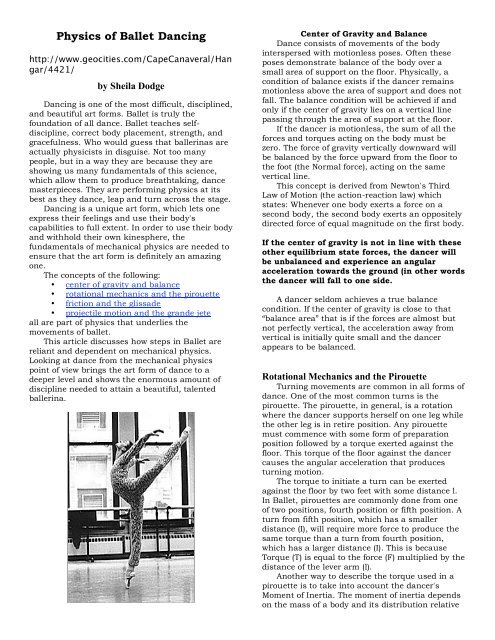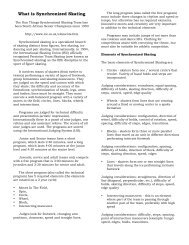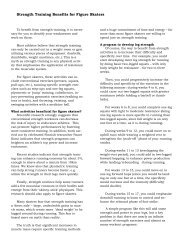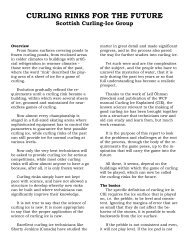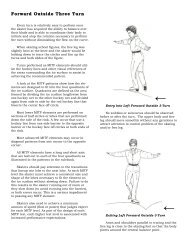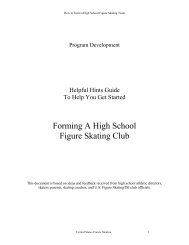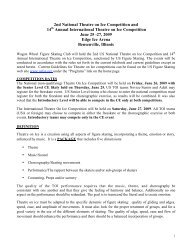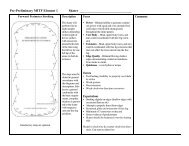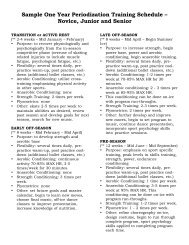Physics of Ballet Dancing - Ice Skating Resources
Physics of Ballet Dancing - Ice Skating Resources
Physics of Ballet Dancing - Ice Skating Resources
Create successful ePaper yourself
Turn your PDF publications into a flip-book with our unique Google optimized e-Paper software.
<strong>Physics</strong> <strong>of</strong> <strong>Ballet</strong> <strong>Dancing</strong><br />
http://www.geocities.com/CapeCanaveral/Han<br />
gar/4421/<br />
by Sheila Dodge<br />
<strong>Dancing</strong> is one <strong>of</strong> the most difficult, disciplined,<br />
and beautiful art forms. <strong>Ballet</strong> is truly the<br />
foundation <strong>of</strong> all dance. <strong>Ballet</strong> teaches selfdiscipline,<br />
correct body placement, strength, and<br />
gracefulness. Who would guess that ballerinas are<br />
actually physicists in disguise. Not too many<br />
people, but in a way they are because they are<br />
showing us many fundamentals <strong>of</strong> this science,<br />
which allow them to produce breathtaking, dance<br />
masterpieces. They are performing physics at its<br />
best as they dance, leap and turn across the stage.<br />
<strong>Dancing</strong> is a unique art form, which lets one<br />
express their feelings and use their body's<br />
capabilities to full extent. In order to use their body<br />
and withhold their own kinesphere, the<br />
fundamentals <strong>of</strong> mechanical physics are needed to<br />
ensure that the art form is definitely an amazing<br />
one.<br />
The concepts <strong>of</strong> the following:<br />
• center <strong>of</strong> gravity and balance<br />
• rotational mechanics and the pirouette<br />
• friction and the glissade<br />
• projectile motion and the grande jete<br />
all are part <strong>of</strong> physics that underlies the<br />
movements <strong>of</strong> ballet.<br />
This article discusses how steps in <strong>Ballet</strong> are<br />
reliant and dependent on mechanical physics.<br />
Looking at dance from the mechanical physics<br />
point <strong>of</strong> view brings the art form <strong>of</strong> dance to a<br />
deeper level and shows the enormous amount <strong>of</strong><br />
discipline needed to attain a beautiful, talented<br />
ballerina.<br />
Center <strong>of</strong> Gravity and Balance<br />
Dance consists <strong>of</strong> movements <strong>of</strong> the body<br />
interspersed with motionless poses. Often these<br />
poses demonstrate balance <strong>of</strong> the body over a<br />
small area <strong>of</strong> support on the floor. Physically, a<br />
condition <strong>of</strong> balance exists if the dancer remains<br />
motionless above the area <strong>of</strong> support and does not<br />
fall. The balance condition will be achieved if and<br />
only if the center <strong>of</strong> gravity lies on a vertical line<br />
passing through the area <strong>of</strong> support at the floor.<br />
If the dancer is motionless, the sum <strong>of</strong> all the<br />
forces and torques acting on the body must be<br />
zero. The force <strong>of</strong> gravity vertically downward will<br />
be balanced by the force upward from the floor to<br />
the foot (the Normal force), acting on the same<br />
vertical line.<br />
This concept is derived from Newton's Third<br />
Law <strong>of</strong> Motion (the action-reaction law) which<br />
states: Whenever one body exerts a force on a<br />
second body, the second body exerts an oppositely<br />
directed force <strong>of</strong> equal magnitude on the first body.<br />
If the center <strong>of</strong> gravity is not in line with these<br />
other equilibrium state forces, the dancer will<br />
be unbalanced and experience an angular<br />
acceleration towards the ground (in other words<br />
the dancer will fall to one side.<br />
A dancer seldom achieves a true balance<br />
condition. If the center <strong>of</strong> gravity is close to that<br />
“balance area” that is if the forces are almost but<br />
not perfectly vertical, the acceleration away from<br />
vertical is initially quite small and the dancer<br />
appears to be balanced.<br />
Rotational Mechanics and the Pirouette<br />
Turning movements are common in all forms <strong>of</strong><br />
dance. One <strong>of</strong> the most common turns is the<br />
pirouette. The pirouette, in general, is a rotation<br />
where the dancer supports herself on one leg while<br />
the other leg is in retire position. Any pirouette<br />
must commence with some form <strong>of</strong> preparation<br />
position followed by a torque exerted against the<br />
floor. This torque <strong>of</strong> the floor against the dancer<br />
causes the angular acceleration that produces<br />
turning motion.<br />
The torque to initiate a turn can be exerted<br />
against the floor by two feet with some distance l.<br />
In <strong>Ballet</strong>, pirouettes are commonly done from one<br />
<strong>of</strong> two positions, fourth position or fifth position. A<br />
turn from fifth position, which has a smaller<br />
distance (I), will require more force to produce the<br />
same torque than a turn from fourth position,<br />
which has a larger distance (I). This is because<br />
Torque (T) is equal to the force (F) multiplied by the<br />
distance <strong>of</strong> the lever arm (l).<br />
Another way to describe the torque used in a<br />
pirouette is to take into account the dancer's<br />
Moment <strong>of</strong> Inertia. The moment <strong>of</strong> inertia depends<br />
on the mass <strong>of</strong> a body and its distribution relative
to the axis <strong>of</strong> rotation. A body <strong>of</strong> given mass will<br />
have a larger moment <strong>of</strong> inertia if the mass is far<br />
from the axis <strong>of</strong> rotation than if it is close. An<br />
arabesque position has a larger moment <strong>of</strong> inertia<br />
than a retire position.<br />
An arabesque turn is different than a pirouette<br />
because the leg is now stretched out behind the<br />
dancer (larger R) rather than close to the dancer at<br />
the knee (smaller R). The moment <strong>of</strong> inertia for the<br />
dancer in arabesque or pirouette position with the<br />
axis <strong>of</strong> rotation going vertically through the center<br />
<strong>of</strong> the body is I=1/3 MR 2. Therefore, the larger the<br />
R, the larger the moment <strong>of</strong> inertia.<br />
If we can determine the angular acceleration (a)<br />
<strong>of</strong> an arabesque turn or pirouette, then we can<br />
determine the torque used to produce it. If we<br />
know angular velocity (w) then we can take the<br />
change in the angular velocity divided by the time<br />
it takes to do the pirouette to find the angular<br />
acceleration.<br />
Using the equation: T=Ia which is analogous<br />
to Newton's second law <strong>of</strong> motion (F=ma), we<br />
can calculate the T used for the turn.<br />
Conservation <strong>of</strong> Angular Momentum<br />
A powerful concept for dance analysis involves<br />
angular momentum. Analogous to linear<br />
momentum (p=mv), angular momentum is given by<br />
: L=Iw. It is a conserved quantity and is a constant<br />
if there are no torques acting on a body. In other<br />
words, the total angular momentum L <strong>of</strong> a body<br />
can change only if there is an external torque<br />
acting on it. There is no way that changes in body<br />
position alone, representing changes in the<br />
configuration <strong>of</strong> mass within the rotating system,<br />
can change the total magnitude <strong>of</strong> L.<br />
It is sometimes claimed that "spotting" the<br />
head one more time can squeeze and extra turn<br />
out <strong>of</strong> a multiple pirouette. But rotating the head<br />
relative to the rest <strong>of</strong> the body does not change the<br />
total angular momentum <strong>of</strong> the body as a whole,<br />
and therefore cannot contribute any extra turning<br />
motion.<br />
The body may descend from turning position<br />
before completion <strong>of</strong> the turn, but the additional<br />
rotation <strong>of</strong> the head gives the appearance <strong>of</strong> a full<br />
additional turn. But once the initial torque against<br />
the floor has been exerted, and the dancer rises on<br />
the supporting foot, the angular momentum L is<br />
constant, decreasing only gradually because <strong>of</strong><br />
friction with the floor.<br />
Friction and the Glissade<br />
Friction involves the properties <strong>of</strong> surfaces,<br />
both chemical and mechanical. Chemical adhesion<br />
and roughness contribute to a frictional force that<br />
acts in a direction tangential to the interface<br />
between the surfaces. Each type <strong>of</strong> surface has its<br />
own coefficient <strong>of</strong> friction. This coefficient <strong>of</strong><br />
friction multiplied by the vertical force<br />
perpendicular to the floor (also called the normal<br />
force) will give the force <strong>of</strong> friction which acts<br />
against the motion <strong>of</strong> the dancer.<br />
Friction is very important in dancing. To<br />
increase friction many ballet dancers use a<br />
substance called Rosin. Rosin has a high<br />
coefficient <strong>of</strong> kinetic friction but a significantly<br />
smaller dynamic coefficient. This means that if the<br />
foot is stationary on the floor a large horizontal<br />
frictional force is possible, but if the foot is moving<br />
that force is much smaller.<br />
This difference is very useful for a dancer<br />
performing glissades, a step which needs this<br />
horizontal force only when the foot is not moving<br />
against the floor. A glissade is a gliding motion<br />
from fifth position to an open stretched position<br />
and then back to a fifth position.<br />
Many dance movements involve sliding on the<br />
floor or rotating against it. Whether a dancer needs<br />
a change in linear horizontal motion as in a<br />
glissade, or an angular acceleration as in a<br />
pirouette, the floor must be able to supply the<br />
horizontal forces that provide for such<br />
accelerations. Too much friction may prevent these<br />
movements.<br />
Projectile Motion and the Grand Jete<br />
All jumps involve vertical accelerations and<br />
forces. Because gravity acts vertically downward on<br />
our bodies at all times, we can only remain<br />
motionless if there is a vertical supporting force<br />
equal to our weight (the normal force). In order to<br />
jump <strong>of</strong>f the ground we need to exert a force<br />
downward against the floor greater than our weight<br />
(mg=mass * acceleration due to gravity for long<br />
enough to achieve the vertical upward velocity<br />
desired.<br />
The height <strong>of</strong> a jump depends on the downward<br />
vertical distance through which that force is<br />
exerted. In order to obtain enough force to jump <strong>of</strong>f<br />
the ground a dancer is required to bend their<br />
knees, a position called plie.<br />
Jumps combined with horizontal motions such<br />
as the grand jete (a leap in which the weight <strong>of</strong> the<br />
body is thrown from one foot to the other) produce<br />
trajectories or have projectile motion. Once the<br />
body loses contact with the floor, the center <strong>of</strong><br />
gravity will follow a parabolic trajectory that is<br />
totally determined by the initial conditions starting<br />
on the ground.<br />
The trajectory will follow the path <strong>of</strong> a normal<br />
projectile- it will begin with an initial velocity<br />
(v0), which will decrease as the dancer rises into<br />
the air until it reaches zero. This is at the<br />
maximum height during the leap. Following this<br />
maximum is the descent to the floor which is<br />
an accelerating downward motion until the<br />
dancer reaches the ground again.
In order to calculate the different parameters <strong>of</strong><br />
this parabolic trajectory, we can employ twodimensional<br />
kinematics. Both the “x“ and the “y”<br />
component must be considered in this case. Also<br />
as in all projectile motions, the initial velocity in<br />
the x direction is equal to the final velocity in the x<br />
direction This means there is no horizontal<br />
acceleration. Finally the acceleration in the y or<br />
vertical direction is always due to gravity (-9.8<br />
m/s 2).<br />
In conclusion dance is truly dependent on<br />
physical concepts such as momentum, Newton's<br />
laws <strong>of</strong> motion, rotational mechanics, and linear<br />
kinematics. Analysis <strong>of</strong> <strong>Ballet</strong> and correct<br />
Technique employs physics to maintain<br />
gracefulness, strength, and an overall sense <strong>of</strong><br />
space required for all beautiful dancers.<br />
List <strong>of</strong> definitions<br />
http://www.geocities.com/CapeCanaveral/Hangar/44<br />
21/definitions.html<br />
© 1997 Sheila Dodge Boston University


